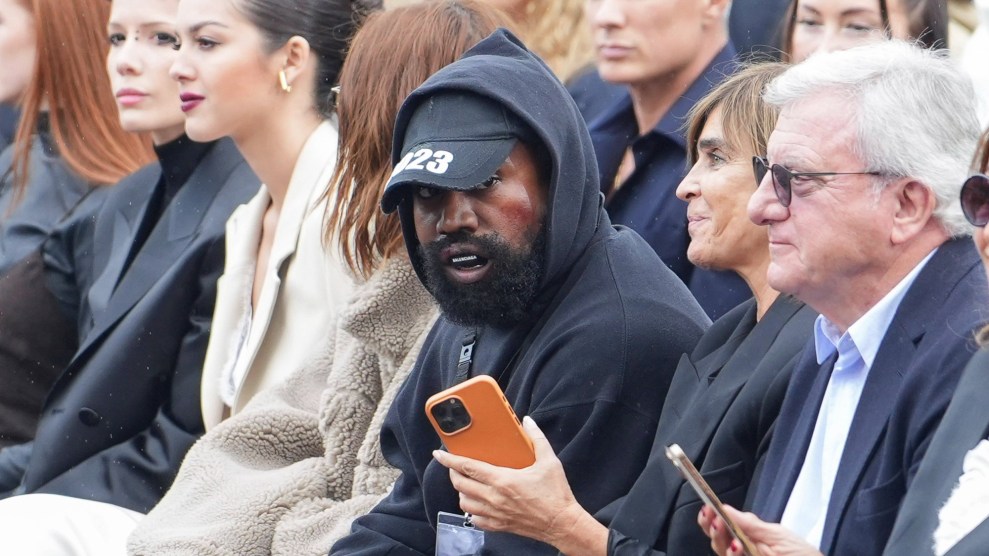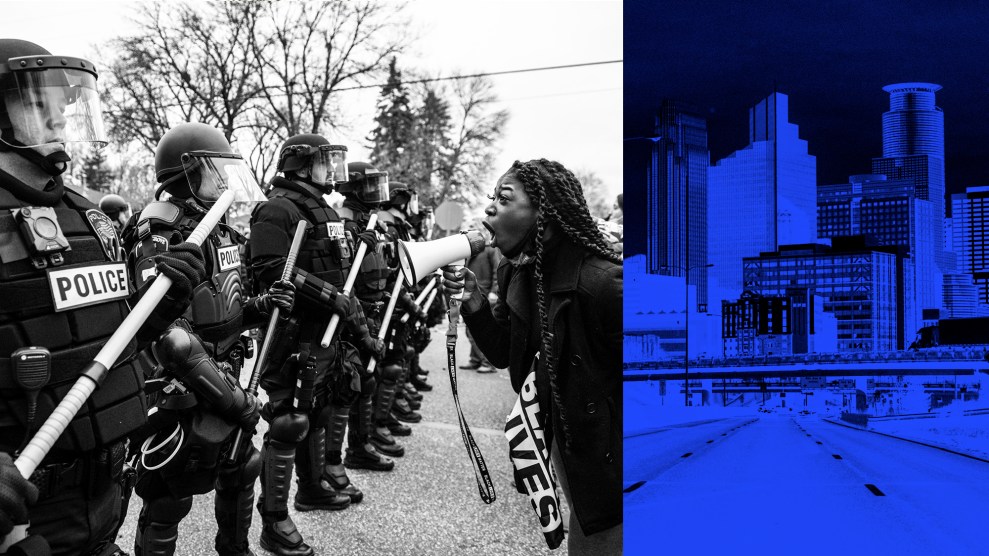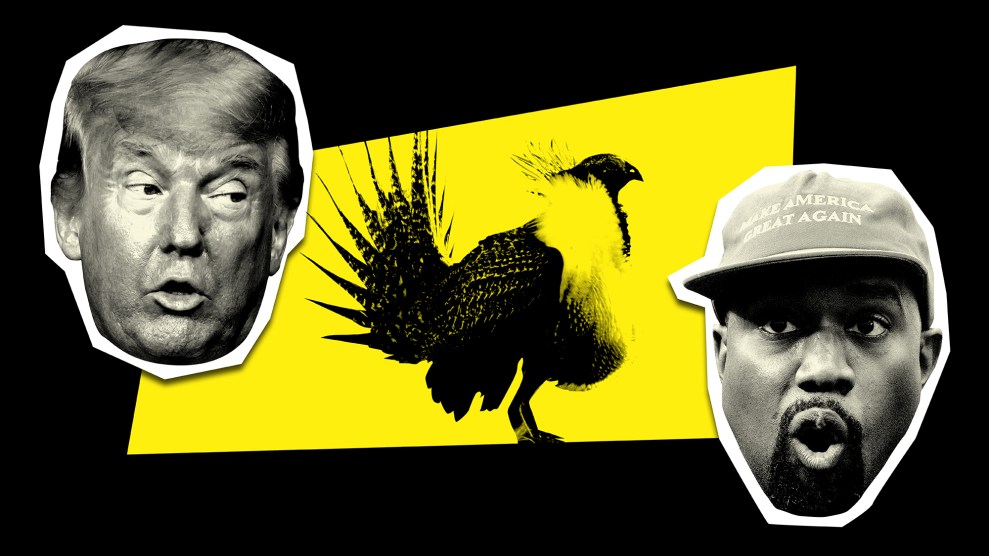On October 16, Kanye West appeared on the popular hip-hop podcast Drink Champs. Hosted by the rapper N.O.R.E. and DJ EFN, Drink Champs is a free-flowing interview show—think of a more convivial version of The Joe Rogan Experience but for rappers and with more booze. At its best, you’ll hear a story from Ghostface Killah about how one time he drove the R&B group The Delfonics to a recording studio (and got in a shootout on the way). At its worst, you’ll get one of the most popular rappers ever ranting with little pushback about “Jewish business secrets.”
Ye’s Drink Champs interview was at the beginning of his current descent. On the show, he said he had been “screwed by the Jewish media.” He said “Jewish Zionists” were responsible for crude tabloid stories about the mother of his children, Kim Kardashian. He said Planned Parenthood was the Holocaust for Black America.
Less discussed since then has been the other gut-wrenching claim made by Kanye West: That George Floyd was killed by a fentanyl overdose. “They hit him with the fentanyl,” said West. “If you look, the guy’s knee wasn’t even on his neck like that.” If you paid attention in 2021 to the trial of “the guy,” Derek Chauvin, you might recognize this argument. It is nearly identical to the defense proffered by the former Minneapolis cop’s attorneys. But West told N.O.R.E. that he lifted them from another source: the far-right media provocateur Candace Owens’ documentary, The Greatest Lie Ever Sold: George Floyd and the Rise of BLM.
Owens has become a Rasputin-like figure in Ye’s recent meltdown. Owens and Ye’s on-again, off-again friendship goes as far back as 2018, when Kanye first donned a MAGA hat and said slavery was “a choice.” Before the Drink Champs episode, he appeared with Owens at Paris Fashion week wearing shirts he designed that read “White Lives Matter.” West was prepared to buy Owens’ husband’s fledgling anti-woke social media platform Parler, but the deal reportedly fell through. As of late, West has gone for the harder stuff, appearing with white supremacist Nick Fuentes on a recent media tour. But before that, he was attending the premiere of The Greatest Lie Ever Sold in Nashville, posing on the red carpet with Owens, just days before appearing on Drink Champs.
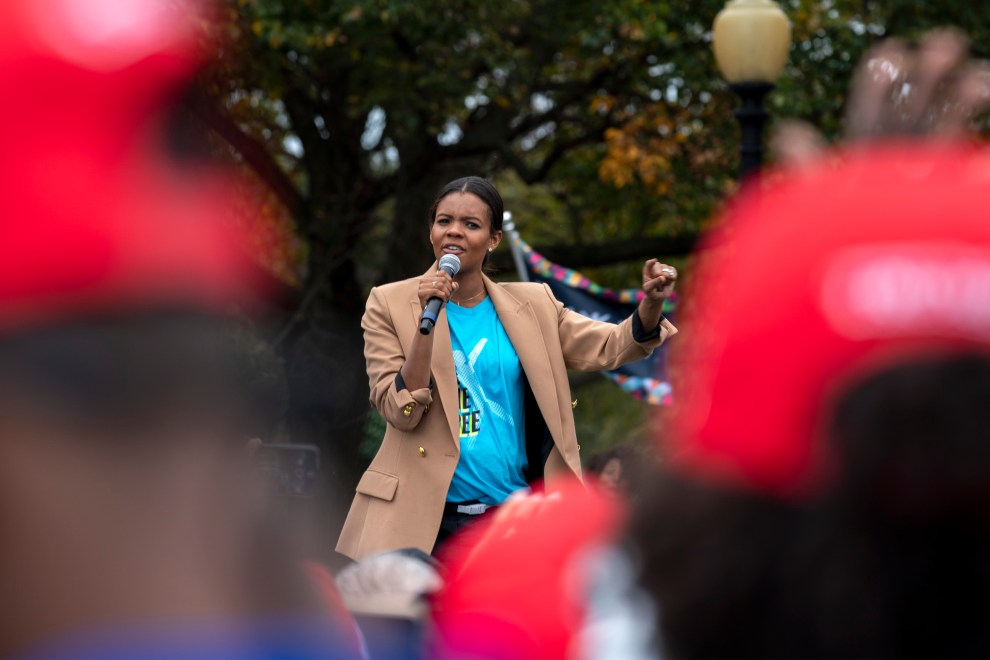
Candace Owens speaks during a rally at the Ellipse before entering to the White House, where President Donald Trump will hold an event on the South lawn on October 10, 2020.
Jose Luis Magana/AP
There is a way of thinking that Ye is uniquely vulnerable to these delusions. This is too hopeful. The film was produced by Ben Shapiro’s The Daily Wire and is the second in a series of right-wing documentaries by the company aiming to expose the evil lurking behind progressive shibboleths. The Daily Wire also produced Matt Walsh’s anti-trans documentary film, What Is A Woman? As reported by the New York Times, Shapiro and The Daily Wire co-CEO, filmmaker Jeremy Boreing, aim to make Nashville a new Hollywood, but without the liberals. This is part of a larger project on the right: to create a parallel media sphere in the hope that culture-war-as-entertainment can help persuade a few more soldiers to join the fight.
These are sleek, professionally edited feature-length documentaries that make salacious claims about some of the biggest news stories of the past decade. They’re ready-made to pick off those unsure of the exact facts in the flurry of the modern information environment. As the writer and filmmaker Jen Senko pointed out in the book and film, The Brainwashing of My Dad, deregulated, fragmented media channels gave rise to conservative talk radio and Fox News, and were key in radicalizing a generation of older Americans like her father—the proverbial Meemaw and Peepaw—into right-wing hysteria. As we have seen with West, it’s worth admitting that many of us are closer to becoming Meemaw and Peepaw than we’d like to admit. We can’t box others, and ourselves, off from the discomfort that we, too, could be deceived by the right kind of flashy agitprop. “I was watching that Candace Owens documentary—documentaries are fucking dangerous,” joked comedian Andrew Schulz, in a widely viewed video reacting to Owens film, about their persuasive power. “They should be illegal.”
Even if in the film, Owens’ argument—that George Floyd wasn’t murdered—is thin, it will work. If you’re someone who thought the Floyd protests in the summer of 2020 were untoward in some way, this film gives you a semi-coherent narrative.
“No one deserves to die,” Owens stipulates early in the film. She then spends the next hour trying to prove that a man did.
The first thing Owens wants us to know is that she wasn’t even going to make this film.
A little over a week after Floyd was killed, Owens recorded a video saying she did not support the protests. She told her phone that the media depiction of Floyd as a martyr for Black America ignored his past criminal record. Then, Cenk Uygur and Ana Kasperian of The Young Turks made fun of her. Dave Chappelle called her “a rotten bitch.” The criticism, Owens says, motivated her to, “scream the truth louder than you scream the lies.”
Owens is the film’s star, narrating and playing the role of the intrepid reporter. The film toggles back and forth between Owens doing on-the-ground shoe leather work; interviewing different talking heads on camera; and editorializing in her own confessional, straight-to-camera monologues. Its style is reminiscent of the left-wing muckraking films of Michael Moore.
Owens’ mission is to exonerate Chauvin by damning Floyd. She argues that because of this “lie”—that Floyd was murdered—the massive nationwide protests set off in Minneapolis were a farce played on the American people. (Owens has trouble sticking with her argument, so she has a backup theory too: Floyd resisted arrest and had a criminal record—so if it wasn’t the drugs, it was that.)
We hear from Ron Martinelli, a forensic criminologist who tells us that Floyd’s true cause of death was a drug overdose, not asphyxiation. This goes against what pulmonologist Dr. Martin Tobin painstakingly narrated during Chauvin’s trial, when he pinpointed the precise moment of Floyd’s death.
Martinelli, like just about every talking head in the film, is presented as a straight shooter with “no dog in this fight,” he says. Ignore the anti–Black Lives Matter book he published in 2016; forget that he told NPR at the time that BLM is “a black nationalist revolutionary Marxist movement that is tied into a much larger international movement referred to as One World One Struggle.”
Like most political propaganda, The Greatest Lie Ever Sold builds its case through lies by omission. Conspiracy theories that are able to take hold rest on small kernels of truth; facts that are exploited and decontextualized.
Owens spends the first section of the movie in Minneapolis, where she gets the closest thing to a scoop the film contains. She introduces us to Alvin Manago and Theresa Scott, who were George Floyd’s roommates at the time of his death. (Owens admits that, in order to gain access to the couple, she and her producers intentionally kept Alvin and Theresa in the dark about what their documentary was trying to prove.)
Alvin and Theresa are kind and welcoming. Alvin met Floyd at a substance abuse treatment center, and then they worked together as security at the restaurant and nightclub Conga Latin Bistro. We get a tour of Floyd’s bedroom. Theresa shows the verses Floyd highlighted in his personal Bible.
We learn that a few weeks before he died, Floyd predicted his death: “I do whatever the police tell me to do because they’re looking to kill a big brother like me,” Theresa remembers Floyd telling her.
“So when it happened, it was eerie,” adds Alvin. “That was one of his fears.”
For Owens, this was the perfect moment to attempt to provoke the couple. “I’m sure you’ve seen the whole tape by now,” Owens begins a question, as the film splices into footage of Floyd’s last moments. “Do you ever look at it and go, ‘man, I wish he would’ve taken his own advice?”
Theresa quietly answers yes.
But the film quickly cuts away before we can see more.
It is difficult to convey how disturbing it is to watch this attempt to get Floyd’s roommates to blame him for his own murder.
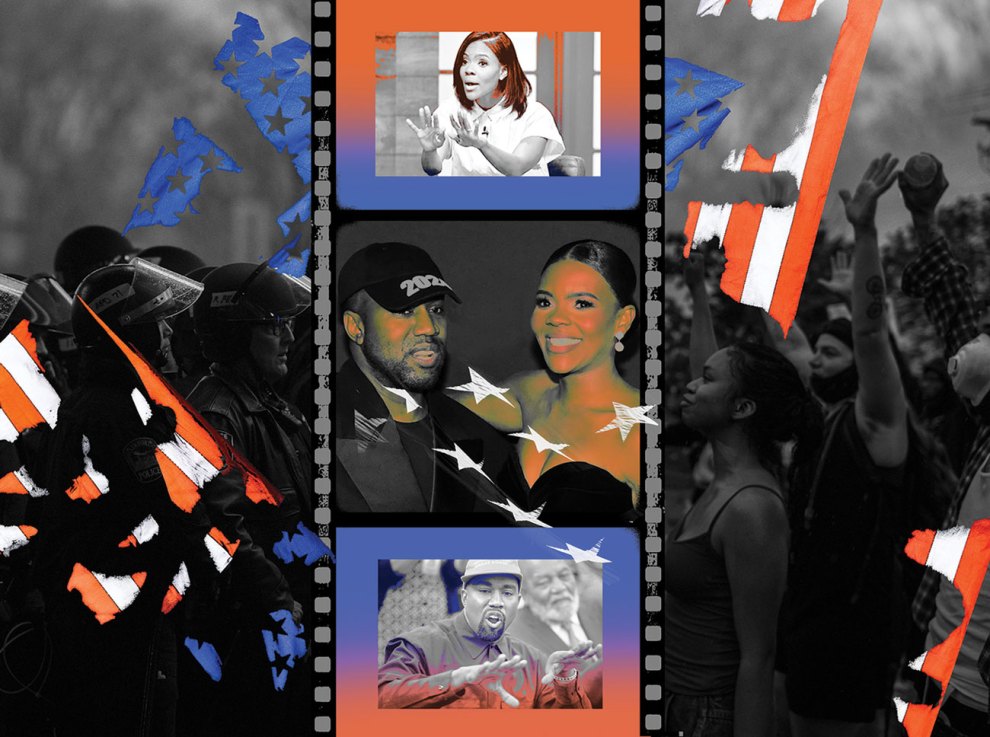
Owens did see a sympathetic figure in all of this: Derek Chauvin. She speaks with Chauvin’s mother on the phone off-camera and pleads with her to participate in the film. She declines, but Owens tells us she “felt her pain.” She speaks with retired Minneapolis police Sergeant Joey Sandberg. He describes Chauvin as levelheaded and quirky. She talks to retired Lieutenant Kim Voss, who explains that Chauvin did not have a racist bone in his body.
This ignores almost everything we know about who Chauvin was. In 2017, Chauvin struck a 14-year-old boy in the head with a flashlight two times. Chauvin knelt on his back for 17 minutes as the boy’s ears began to bleed. During the trial, prosecutors on Chauvin’s case attempted to introduce seven other incidents where Chauvin held someone in a prone position or used a neck restraint for an unreasonably excessive amount of time. Voss, Chauvin’s character witness, was a commander at the infamous Third Police Precinct, where Chauvin worked. In a story in the Minneapolis Star Tribune, a civil rights lawyer called it a “playground for rogue cops,” where her clients were regularly subjected to anal-cavity searches.
None of this makes it into the film. Instead, Owens says Chauvin was unfairly maligned. From there, she reasons: If we’ve been misled about Chauvin, we’ve probably come to the wrong opinion on the Black Lives Matter movement too. We hear from former local television reporter Liz Collin and her husband, Bob Kroll, the former Minneapolis police union head. They’re presented as victims of a bloodthirsty woke mob. While it’s true that protesters did beat effigies of the couple outside of their house, what’s missing is that Kroll is not just any cop, but perhaps the most notoriously racist cop in modern Minneapolis history. Collin, meanwhile, recently published a tell-all book in the vein of Owens’ documentary, called They’re Lying: The Media, The Left, and The Death of George Floyd.
In an attempt to further demonize protest, Owens is taken on a tour of the intersection where Floyd was murdered in south Minneapolis. Her guide is a minister named Charles Karuku, who is depicted as a local sage. It’s telling that Owens chose Karuku to lead her tour through George Floyd Square. There is no shortage of Black faith leaders in the area. In the mile or so radius around the intersection of 38th Street and Chicago Avenue, there are at least five churches with predominantly Black congregations. Karuku’s congregation is in a suburb 15 miles away from the memorial. It’s a pentecostal church where Karuku performs instant miracles. He has claimed to cure chronic back problems and even heal cancer.
Karuku and Owens walk around the intersection that has since become a memorial site and a controversial semi-autonomous zone (street barricades were cleared out by the city in the summer of 2021) held down by a mix of activists and neighborhood residents. Owens marvels at the thought of an autonomous zone and the memorial constructed around the exact site of Floyd’s death. She asks Karuku if Floyd is the wrong role model.
“We have better people to follow. Jesus Christ and Martin Luther King Jr.,” says Karuku.
What seems to eat at Owens the most is that so many people across the country had compassion. She genuinely can’t believe that so many took to the streets on behalf of a flawed human being, a stranger. This solidarity—fighting for someone you don’t know—seems foreign to her. It can only be explained by manipulation.
In her third act, Owens presents a conspiracy in the form of the Black Lives Matter Global Network. There are no big gotcha moments in Owens’ exposé that have not already been reported on by other outlets: that BLM Global Network co-founder and former executive director Patrisse Cullors used donation funds to covertly purchase a $6 million house whose purpose is unclear; that Cullors put her family on the payroll; that the group’s overall financial picture lacks the transparency that is expected of a prominent tax-exempt, nonprofit organization leading a social movement. In what would be the climax, Owens visits the Los Angeles home of Cullors and stands outside the fence. She is told to leave.
As she goes through their tax forms with a fine-toothed comb, Owens is much less focused on the substantive criticisms leveled at BLM Global Network by other BLM chapters and parents of the movement’s martyrs like Michael Brown Sr. or Samaria Rice. She reserves her outrage for the revelation that trans-rights organizations received donation money from the BLM Global Network.
That the facts of these improprieties may come as revelations to viewers is partly a product of journalistic failure. A failure that fuels the right-wing media machine’s claims that liberals are lying to you. Without diligent, good faith reporting like that of journalist Sean K. Campbell—whose series of articles for New York magazine on the BLM Global Network was an instance of rare, thorough exposé on the group from a major left-leaning outlet—opportunities arise for right-leaning outlets like the Washington Examiner or the New York Post to break the stories. It provides malicious actors like Owens opportunities to exploit.
The kernel here is that there are fissures within a movement. That some may use a broad political project for personal profit. That the reality of George Floyd the man has been at times ignored as he has become a symbol. None of this can be used to rationalize his murder, or explain it. Yet, that is Owens’ goal. “The real story is a story of addiction,” she says in the film’s final moments. “It’s a story of a man who overdosed…You were all lied to. That’s the truth.”
In the end, Candace Owens is doing exactly what she thinks she’s exposing: lying to profit off a Black man’s untimely death.
Top illustration: Jason Davis/Getty (4); Elizabeth Flores/Star Tribune/Getty; Ira L. Black/Corbis/Getty; Chandan Khanna/AFP/Getty; Kerem Yucel /AFP/Getty; Stephen Maturen/Getty. Second illustration: Jason Davis/Getty (2); Richard Tsong-Taatarii/Star Tribune/Getty; Chandan Khanna/AFP/Getty; Oliver Contreras/Pool/Getty; Stephen Maturen/Getty

